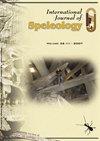The nitrogen dynamics of Deer Cave, Sarawak, and the role of bat caves as biogeochemical sinks in Tropical Moist Forests
IF 1.3
4区 地球科学
Q3 GEOSCIENCES, MULTIDISCIPLINARY
引用次数: 1
Abstract
A better understanding of the role of bat caves as nitrogen sinks in tropical moist forest ecosystems can be expected to shed light on regional and spatial variability in nutrient recycling studies. We measured the nitrogen flux (in air and water) associated with a very large Chaerephon plicata bat colony in Deer Cave, Borneo, in the process generating a new, quantitative, estimate of the total bat population (774,828 ±48,320), and the first detailed modelling of an ammonia plume in a cave. Long-term storage of N does not occur in this wet cave. Our final budget numbers indicate that, of the daily input of N (i.e., ecologically-useful fixed-N in guano) to this cave, ammonia production is minor (and most of it is exported in water rather than air). The conclusion is that the export budget is dominated (perhaps as large as 94.4%) by microbial denitrification of fixed-N to diatomic N exported in air. Deer Cave thus acts as a nitrogen sink, potentially removing up to 39% of the ecologically-useful fixed-N from the total forest nitrogen budget over an area of hundreds of square kilometers.沙捞越鹿洞的氮动态及蝙蝠洞在热带潮湿森林生物地球化学汇中的作用
更好地了解蝙蝠洞穴在热带潮湿森林生态系统中作为氮汇的作用,有望为营养循环研究的区域和空间变异性提供线索。我们测量了与婆罗洲鹿洞一个非常大的褶皱斑蝶蝙蝠群落相关的氮通量(空气和水中),在这个过程中,我们对蝙蝠总数(774828±48320)进行了新的定量估计,并首次对洞穴中的氨羽流进行了详细建模。在这个潮湿的洞穴中,氮不会长期储存。我们的最终预算数字表明,在这个洞穴每天输入的氮(即鸟粪中对生态有益的固定氮)中,氨的产量很小(大部分是通过水而不是空气出口的)。结论是,出口预算主要(可能高达94.4%)由空气中出口的固定氮到双原子氮的微生物反硝化作用决定。因此,鹿洞起到了氮库的作用,有可能从数百平方公里的森林总氮预算中去除高达39%的生态有用的固定氮。
本文章由计算机程序翻译,如有差异,请以英文原文为准。
求助全文
约1分钟内获得全文
求助全文
来源期刊

International Journal of Speleology
地学-地球科学综合
CiteScore
3.10
自引率
23.10%
发文量
12
审稿时长
>12 weeks
期刊介绍:
The International Journal of Speleology has the aim to get cave and karst science known to an increasing number of scientists and scholars. The journal therefore offers the opportunity to all scientists working in and on karst to publish their original research articles or their review papers in an open access, high quality peer reviewed scientific journal at no cost. The journal offers the authors online first, open access, a free PDF of their article, and a wide range of abstracting and indexing services.
 求助内容:
求助内容: 应助结果提醒方式:
应助结果提醒方式:


